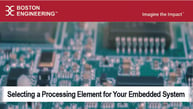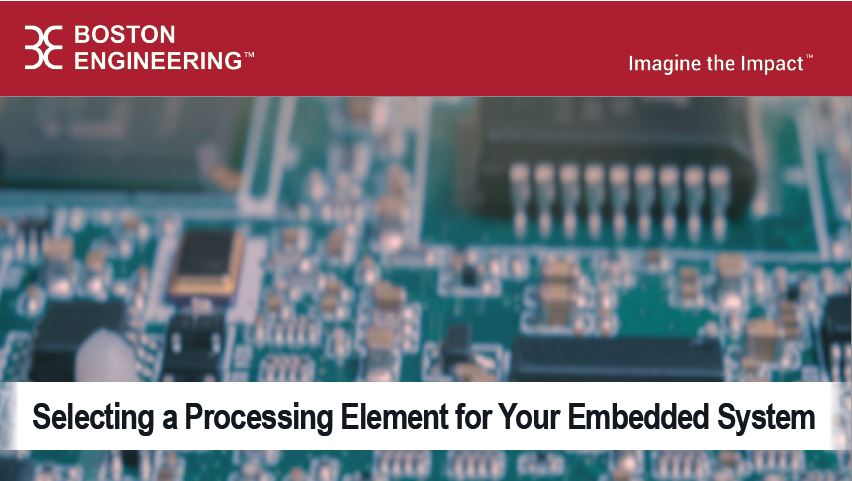Know the Marketplace when Selecting a Processing Element for Your Embedded System
 This article is an excerpt from the Boston Engineering "Selecting a Processing Element for Your Embedded System" white paper. For a copy of the the complete publication, visit the Selecting a Processing Element for Your Embedded System download page.
This article is an excerpt from the Boston Engineering "Selecting a Processing Element for Your Embedded System" white paper. For a copy of the the complete publication, visit the Selecting a Processing Element for Your Embedded System download page.
4. Know the Marketplace::
Product design benefits from an understanding of the market you’re selling into and the supply chain that supports that market. Products targeted at durable goods, industrial, medical, and other long-term markets need to be designed with parts that are promised to be around for a long time. A rapid proof of concept does not. If you’re designing for one of these long-term markets, then select a processing element that the manufacture is committed to making for the life of the product. This information is often not on the data sheet. Sometimes you can find life cycle information on a part, but its best to call the manufacturer and find out. If there is significant impact to a part going obsolete and your volume is high enough to be of interest to that manufacturer, then get your supply chain managers to make a deal for production.
Embrace the future trends that are shaping a new era of engineering excellence.
Boston Engineering is a multidisciplinary engineering consulting firm that is often faced with the task of selecting a processing element (MCU, MPU, Single board computer, FPGA, SoC, or SoM) for an embedded system. This can be a simple or complicated task based on the project. Fortunately, one can take the same steps to select the processing elements for most embedded systems.
Download for groundbreaking insights!
The quantity of the product you’re designing matters. When designing for high production quantities you can often trade NRE against cost of goods sold. An example of this is deciding to use a smaller MCU and use bare metal (no OS) programming so the application can find into it. Bare metal can take longer but savings on the smaller part can more than pay for the increased NRE.
Designing for an Industrial, medical, or other long duration market means that the processor you select needs to be around for the product life cycle, or at least until you intend to redesign it. In these cases, getting the supply chain involved with processing element selection is important. The job here is to make sure that whatever you select is going to be produced and available.
For a copy of the the complete publication, visit the Selecting a Processing Element for Your Embedded System download page.
.png?width=760&height=133&name=Surgical%20Robotics%20(1).png)
As the engineering landscape continues to evolve, Boston Engineering is committed to proactively integrating cutting-edge technologies and methodologies into the solutions it delivers, ensuring that clients stay at the forefront of industry trends and maintain a competitive edge.
About the Authors
Aaron Pailes
Sr. Principal Systems Engineer, Boston Engineering
Aaron is a skilled and versatile engineer with a strong background in systems and design engineering. He has contributed significantly to various technological advancements, including side scan sonar platforms, innovative sonar nadir filling technology, security scanners, network monitoring equipment, and RADAR systems
Kathryn Stringer
Electrical Engineer, Boston Engineering
Kathryn designs diverse electrical prototypes for medical/defense sectors, adept in PCB design, testing, and rapid breadboard creation. She collaborates on custom electronics for medical devices and ROV applications.
Tanner Jameson
Electrical Engineer, Boston Engineering
Tanner is a Tufts University graduate, specializing in collaborative circuitry design, software and hardware integration, and product prototyping.
Ready to learn more about Boston Engineering?
For almost three decades, Boston Engineering has designed, developed, and optimized devices and technologies the medical, Commercial, and Defense communities rely on to improve the way people work and live. We provide solutions to the challenges society faces.
Our expertise includes industrial design and product redesign, sensors and control systems, robotics technical innovation, and digital software solutions.
Imagine your Impact: Stay up-to-date with the latest insights and trends we're watching. Add your email address below and sign up for a monthly summary of our most impactful posts!











